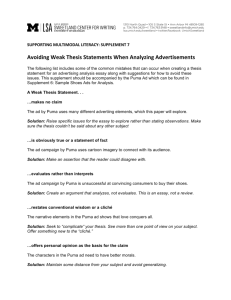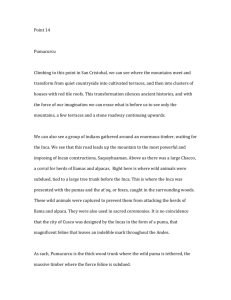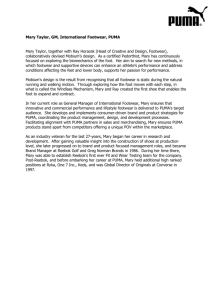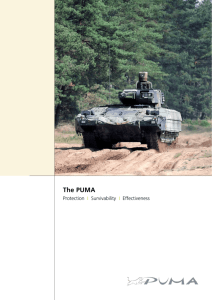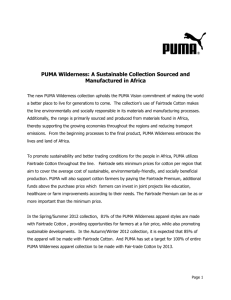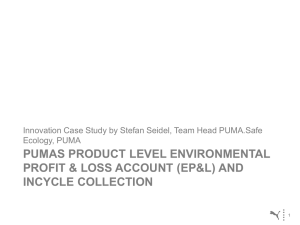Climate Control Helps PUMA Stay at the Top of Its Game
advertisement
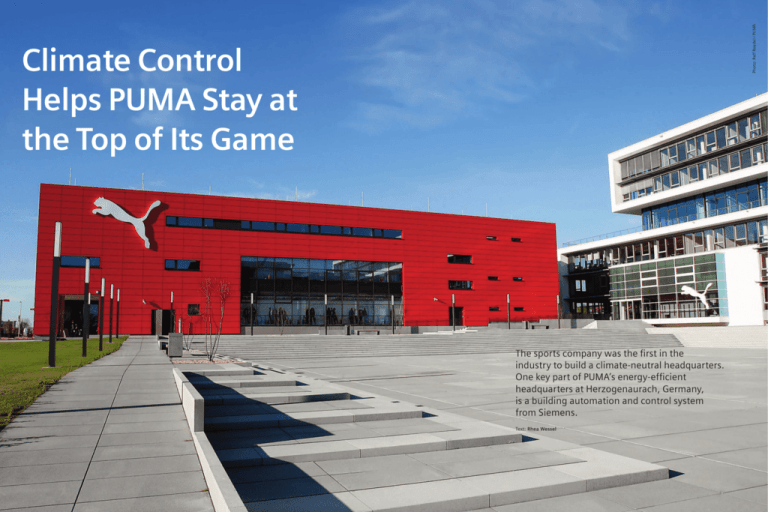
Campus Climate Control Helps PUMA Stay at the Top of Its Game The sports company was the first in the industry to build a climate-neutral headquarters. One key part of PUMA’s energy-efficient headquarters at Herzogenaurach, Germany, is a building automation and control system from Siemens. Text: Rhea Wessel 44 urbanDNA · Issue 3 / December 2013 urbanDNA · Issue 3 / December 2013 45 Photo: Ralf Roedel / PUMA Campus Campus PUMA designs and sells footwear, clothing, and accessories and has been worn by football greats such as Pelé and Diego Maradona as well as track star Usain Bolt. PUMA had sales of about €3.27 billion in 2012 and employs around 11,000 people worldwide. PUMA’s campus – called the PUMAVision Headquarters – consists of three buildings that flank a PUMA community plaza, not far from the hustle and bustle of Nuremberg. Once they’ve passed through the signature retail shop – a building designed to look like PUMA’s iconic red shoe box – visitors see a glass building to the left. It holds offices for management and teams working in administration, marketing, and branding, as well as other functions. This six-level glass construction is connected via walkways on each level to the last large structure on the campus – a multimedia hall and conference center at the furthest point on the back of the plaza. Creative Climate Inside the complex, some 650 people work to keep PUMA at the top of its game. The creative types typically move around, interact, and seek an environment where they can think outside of the box. On any given day, for instance, employees might take a break for a game of table tennis, bouncing ideas off one another. Or they may seek out a quiet spot in an armchair in one of the socalled “chill-out” lounges, putting pen to paper for a brainstorming session. To perform their best, people need optimal amounts of light, air circulation, and heat or air-conditioning. At the campus, PUMA has installed a completely automated, demandbased system to provide just this in all three buildings. And – equally important – the building’s automation and control system is part of a campus that is completely CO2 neutral. PUMA’s headquarters campus was the first in the sporting goods industry to be built and operated that way. Personal Zones LEDs play a key role in the lighting concept of the PUMA headquarters. 46 urbanDNA · Issue 3 / December 2013 Provided by Siemens, the building automation and control system called Desigo allows employees to regulate on a room-by-room basis natural light, electric lighting, the temperature, and air circulation. Employees at PUMA strike a pose with the latest styles – and brand ambassador and Olympic gold medalist Usain Bolt. Photo: Christoph Maderer / PUMA ot far off the autobahn in southern Germany, nestled among green fields and patches of forest, rises a giant, fire-enginered building, dressed with a familiar logo: a white mountain lion leaping for the prize. At night, PUMA can switch on a stark red LED version of the facade to light up the horizon on special occasions. The striking red edifice is the entrance to the headquarters of PUMA, a brand known around the world for high quality, sportsmanship, and a young, hip lifestyle that is focused on the pleasure of the game. Photo: Ralf Roedel / PUMA N Campus At the same time, the building manager can monitor and regulate the entire system from a single desktop control station. Ralf Habermann, the head of IPM (Innovatives Projektmanagement für Gebäudeleittechnik), the company that implemented the Desigo building automation and control system on behalf of PUMA, says: “In principle, each employee can determine his or her own climate zone. I think employees expect this standard and comfort from a company that is focused on delivering high quality.” In large spaces as well, Desigo adapts to the needs of occupants. When a storm brews suddenly and clouds block the sun, the temperature in PUMA’s retail shop and cafeteria at the entrance of the campus may drop quickly. The Desigo temperature monitors pick up on this, adapting the air temperature for shoppers inside the building. When PUMA holds a fashion show for the press, modeling the next seasons’ sport and lifestyle fashions to a pulsing beat, the air temperature and air flow inside the multimedia hall (called the Brand Center) is u PUMA’s headquarters was the first in the sporting goods industry to be CO2 neutral. urbanDNA · Issue 3 / December 2013 47 Campus Campus For Habermann, it makes sense to enhance building automation and control systems with energy management features. “This allows malfunctions and faults to be identified as early as possible and ensures that energy-saving features yield longterm benefits,” he says. Demand-Based Operation Contrary to conventional buildings, where HVAC systems run on the principle of supply, the provision of heating, ventilation, and air-conditioning at the PUMAVision headquarters is based on actual demand in each room. All heat consumers are recorded and controlled via Desigo PX stations. Predefined and calculated set points are forwarded to the corresponding precontrol group, where they are converted into matching “demand” Desigo controls the concrete core tempering system via the Desigo TABS Control application. signals. The recirculating pumps for the heating groups and the chilledwater system are incorporated into the demand-based control system. The required water volume is calculated, controlled, and monitored based on demand, either by sensors that detect the weakest spot in the system in terms of energy flow, or by the employees that require heating or cooling. The control system works with comprehensive energy management functions, which extend from the room level to the heating/cooling generators and ensure demandbased operation. The 35,000-square-meter PUMAVision Headquarters runs on renewable energy generated by 1,000 square meters of photovoltaic panels on the roof of the red shoe box building and another 140 square meters of panels automatically adapted to the lights and crowds of up to 1,500 people. Adapting for Energy Efficiency 48 urbanDNA · Issue 3 / December 2013 PUMA Group – Company Footprint • Founded October 1, 1948, in Herzogenaurach, Germany • Owns PUMA, Cobra Golf, and Tretorn brands • Product sales in 120 countries • About 11,000 staff worldwide • Headquarters: Herzogenaurach/Germany, Boston, London, Hong Kong • Consolidated sales for financial year 2012: €3.27 billion, half of which in footwear Photo: Christoph Maderer / PUMA “One special feature at the PUMAVision Headquarters is the ability to adjust the throw distance of the air outlets in the multimedia hall. If cooling is needed, the conditioned air is diffused; if heating is needed, the warm air is blown straight down from the ceiling,” says Habermann. The campus was designed to use renewable energy efficiently. For example, lights are turned off automatically when the room has sufficient daylight or is unoccupied. It also features thermally activated concrete slabs, switchable heat pumps for heating and cooling, and facadeoriented fan coils. The air-conditioning outlets in the multimedia hall can be adjusted to diffuse cool air or provide direct jets of warm air. integrated into the facade of the south side of that building. Any remaining energy needs are met with energy purchased through a supplier of renewable energy and a carbon offset project in Turkey. IPM continues to maintain and service the PUMAVision Headquarters, ensuring that the Desigo building automation and control system is updated with the latest software releases and managing the network of about 20 control cabinets that are distributed across the buildings and controlled by Desigo. At times, the system must be adapted when PUMA moves employees around within the building, constructing or breaking down office walls in the interior. “It’s relatively easy to adjust for new parameters within the building,” says Habermann. “That’s part of the beauty of Desigo.” p Rhea Wessel is a freelance technology writer based near Frankfurt, Germany. A creative session at the PUMA headquarters, not far from the hustle and bustle of Nuremberg. urbanDNA · Issue 3 / December 2013 49
